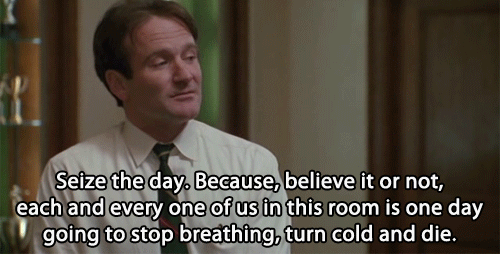
Mind Depiction
MY DIGITAL PORTFOLIO
Miscellany/ Projects
Time Worth Taking- A Carpe Diem Essay
In the movie Dead Poets Society, Mr. Keating teaches his students about the notion of “Carpe Diem”, or seizing the day. Seizing the day, as he describes it, seems to be the instantaneous action a person takes. What if it wasn’t a single moment’s worth of action? What if Carpe Diem is actually a journey that has a progression of steps to be followed? Through numerous texts, this journey is quite visible to anyone who takes the time to look.
The first step would be finding a reason to act. Humans require a motivator to start the journey. According to Newton’s First Law, an object at rest stays at rest unless acted upon by an outside force. This can be applied to people as well. People don’t act unless they have a reason, a motivator, an outside force. For example, in Dead Poets Society, Todd Anderson is seen struggling with the fact that Mr. Keating is fired. Todd’s motivator in this scenario was seeing his favorite teacher being mistreated. Throughout the movie, Todd is fairly stagnant. He doesn’t make decisions and continuously doubts himself and his abilities.However, his sense of right and wrong told him that he had to act against such an injustice. It is this scene that inspires him to take a stand.
Following that step, comes step number two: making the decision to act. During this step, a person would consider the pros and cons of acting and come to a solid conclusion as to what they will do. This is a separate step from acting because a decision can be made to not act, even if there is a reason to. A lack of bravery is what usually will hold a person back from making the choice to act. Steve Jobs once put this idea of needing bravery to make decisions into a very eloquent commencement speech he did at Stanford. In reference to him making the decision to drop out of college, he said, “Again, you can’t connect the dots looking forward; you can only connect the dots looking backwards. So you have to trust that the dots will somehow connect in your future” (Jobs). Making decisions can be frightening so a person must be daring enough to seize the day and all it has to offer.
Another example of someone making the choice to act would be how Neil, from Dead Poets Society, was excited about possibly joining a production of A Midsummer Night’s Dream He was going on and on about it to Todd. Despite Todd’s arguments as to why it wasn’t a good idea, Neil says he is going to do it anyway. This decision is risky for Neil because of how harsh his father is, but he chooses to perform anyway. His bravery is what allows him to continue on the Carpe Diem journey.
The next step is probably what comes to mind when most people hear the phrase “Carpe Diem.” This is the stage where the action occurs. This is the point when a person follows through on their decision. This happens during the story “Antaeus” when T.J. and the gang start their roof garden project by bringing up the dirt to the roof (Deal 191). This is when the boys have actually moved past the second step and are transferring their decision from their minds to reality.
Some people may believe that this is where the journey draws to a close. The day was seized. End of story. I see how people can think this way because most people would not call Carpe Diem a lifelong journey. They would say it is a means to an end. People do what they must to get from Point A, a place where they feel the desire for change, to Point B, a place where they’ve claimed the rewards of taking a chance.
Carpe Diem becomes a lifelong journey when we change our perspective on what it truly is. Carpe Diem is a philosophy to live by about how we cannot take time for granted. When viewed through this lens, the next step is to repeat the journey. This is exemplified by the “Nows” from the book Einstein’s Dreams, who believe “...that with infinite lives, they can do all that they imagine” (Lightman 136). They constantly seize the day and go through the journey to accomplish what they dream about since time no longer limits them. While we don’t have an infinite number of lives, we are able to live our single life under similar principles.
Unfortunately, when the matter of perspectives comes into play, it can be tricky to come to a definite conclusion as to how Carpe Diem should be viewed. Is it a means to an end or a philosophy? This really has to be decided at an individual level, but it remains a journey either way.
The Carpe Diem journey is simple to explain, but is complicated and messy when put into effect. More often than not, the journey ends before it reaches the final stages. People get scared or lazy and can’t follow through. The rarity of actually following all the steps is what gives the idea such an allure to people in search of changing their lives. To them, completing the journey may very well be worth their time.
Works Cited
Dead Poets Society. Buena Vista Pictures Distribution, 1989.
Deal, Borden. Antaeus. 1962.
Jobs, Steve. “Commencement Speech.” Stanford University, 12 June 2005, Serra Mall, Stanford. Speech transcript.
Lightman, Alan. Einstein’s Dreams. Pantheon Books, 1993.



